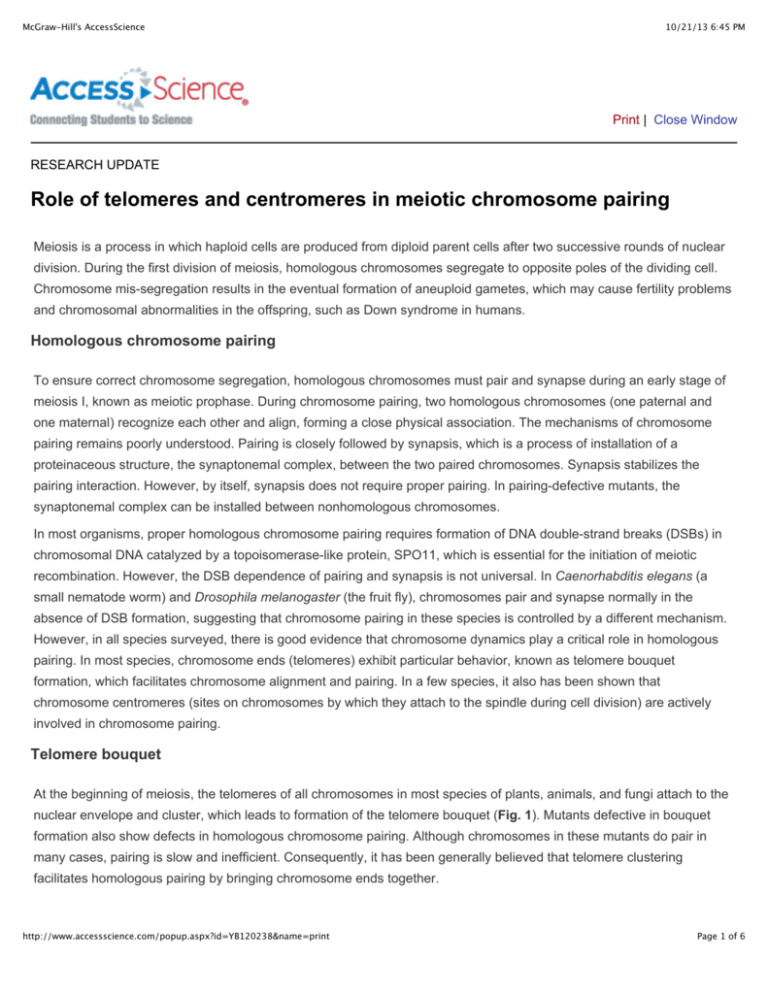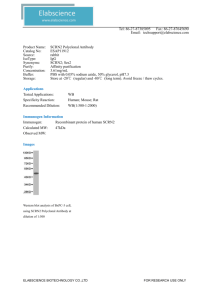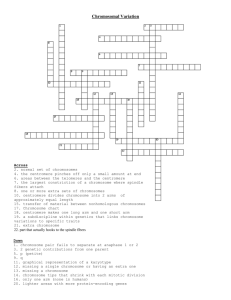
McGraw-Hill's AccessScience
10/21/13 6:45 PM
Print | Close Window
RESEARCH UPDATE
Role of telomeres and centromeres in meiotic chromosome pairing
Meiosis is a process in which haploid cells are produced from diploid parent cells after two successive rounds of nuclear
division. During the first division of meiosis, homologous chromosomes segregate to opposite poles of the dividing cell.
Chromosome mis-segregation results in the eventual formation of aneuploid gametes, which may cause fertility problems
and chromosomal abnormalities in the offspring, such as Down syndrome in humans.
Homologous chromosome pairing
To ensure correct chromosome segregation, homologous chromosomes must pair and synapse during an early stage of
meiosis I, known as meiotic prophase. During chromosome pairing, two homologous chromosomes (one paternal and
one maternal) recognize each other and align, forming a close physical association. The mechanisms of chromosome
pairing remains poorly understood. Pairing is closely followed by synapsis, which is a process of installation of a
proteinaceous structure, the synaptonemal complex, between the two paired chromosomes. Synapsis stabilizes the
pairing interaction. However, by itself, synapsis does not require proper pairing. In pairing-defective mutants, the
synaptonemal complex can be installed between nonhomologous chromosomes.
In most organisms, proper homologous chromosome pairing requires formation of DNA double-strand breaks (DSBs) in
chromosomal DNA catalyzed by a topoisomerase-like protein, SPO11, which is essential for the initiation of meiotic
recombination. However, the DSB dependence of pairing and synapsis is not universal. In Caenorhabditis elegans (a
small nematode worm) and Drosophila melanogaster (the fruit fly), chromosomes pair and synapse normally in the
absence of DSB formation, suggesting that chromosome pairing in these species is controlled by a different mechanism.
However, in all species surveyed, there is good evidence that chromosome dynamics play a critical role in homologous
pairing. In most species, chromosome ends (telomeres) exhibit particular behavior, known as telomere bouquet
formation, which facilitates chromosome alignment and pairing. In a few species, it also has been shown that
chromosome centromeres (sites on chromosomes by which they attach to the spindle during cell division) are actively
involved in chromosome pairing.
Telomere bouquet
At the beginning of meiosis, the telomeres of all chromosomes in most species of plants, animals, and fungi attach to the
nuclear envelope and cluster, which leads to formation of the telomere bouquet (Fig. 1). Mutants defective in bouquet
formation also show defects in homologous chromosome pairing. Although chromosomes in these mutants do pair in
many cases, pairing is slow and inefficient. Consequently, it has been generally believed that telomere clustering
facilitates homologous pairing by bringing chromosome ends together.
http://www.accessscience.com/popup.aspx?id=YB120238&name=print
Page 1 of 6
McGraw-Hill's AccessScience
10/21/13 6:45 PM
Fig. 1 (a) A diagram of the telomere bouquet. The telomeres of all chromosomes are clustered on the nuclear envelope.
Centromeres are also shown. (b) The telomere bouquet in a wild-type maize nucleus during meiotic prophase. The telomeres and
chromatin are indicated. (Image courtesy of M. Sheehan; adapted from A. Ronceret and W. P. Pawlowski, Chromosome dynamics
in meiotic prophase I in plants, Cytogenet. Genome Res., 129:173–183, 2010)
Bouquet formation has not been observed in some organisms, including Arabidopsis thaliana (thale cress) and C.
elegans. In C. elegans, telomeres attach to the nuclear envelope during early prophase I, but do not cluster. In
Arabidopsis, telomeres cluster during interphase and at the beginning of meiotic prophase on the nucleolus rather than
on the nuclear envelope. Telomeres of homologous chromosomes pair at the beginning of meiosis and dissociate from
the nucleolus without forming the typical bouquet. However, during early meiotic prophase, telomeres become associated
with the nuclear envelope and occasionally exhibit loose clustering. Overall, although a bona-fide bouquet is not formed
in Arabidopsis or C. elegans, some features of the bouquet formation process, such as telomere attachment to the
nuclear envelope, are present. These remnant features might play roles similar to the role of the bouquet in facilitating
chromosome pairing.
Telomere–nuclear envelope attachment and telo-mere dynamics
Studies in several species, particularly fission yeast, have led to identification of a number of proteins involved in
telomere attachment to the nuclear envelope (Fig. 2) and bouquet formation. In fission yeast, the Taz1 protein, which
acts to maintain the proper copy number of telomeric repeats, has been shown to be required for bouquet formation. This
protein interacts with three other telomere-associated proteins: Rap1, Bqt1, and Bqt2. The Rap1/Bqt1/Bqt2 protein
complex forms a link between the telomeres and Sad1, a transmembrane protein located in the inner membrane of the
nuclear envelope. Sad1 homologs have been identified in a number of diverse species, including budding yeast, mice, C.
elegans, Drosophila, Arabidopsis, and maize. They are distinguished by the presence of an evolutionarily conserved
SUN domain. Sad1 binds another transmembrane protein, Kms1, which is located in the outer membrane of the nuclear
envelope and which interacts on its cytoplasmic end with the cytoskeleton and cytoskeletal motor proteins. Kms1
http://www.accessscience.com/popup.aspx?id=YB120238&name=print
Page 2 of 6
McGraw-Hill's AccessScience
10/21/13 6:45 PM
homologs have been also identified in many species, such as Drosophila, C. elegans, and mammals, and are collectively
known as KASH proteins. The SUN/KASH protein pairs function in meiosis by linking chromosome ends with the
cytoplasmic cytoskeleton (Fig. 2). The two proteins also function outside of meiosis, and their exact roles are still not well
understood.
Fig. 2 A diagram showing the telomere–nuclear envelope attachment. Telomeres connect to the nuclear envelope through a
telomere-associated and a SUN domain proteins. The SUN domain protein in the lumen of the nuclear envelope interacts with a
KASH protein, which also interacts with the cytoplasmic cytoskeleton.
In a number of species, including budding and fission yeasts, rats, mice, C. elegans, and maize, it has been observed
that chromosomes exhibit dynamic and complex movements during early stages of meiotic prophase. These movements
are particularly dramatic in fission yeast, where they are known as “horse-tail” movements, in which the entire nucleus
moves violently back and forth. In maize, several types of meiotic prophase chromosome movements have been
observed. Rapid short-distance movements of fairly small chromosome segments adjacent to the telomeres coincide with
chromosome pairing. At the same time, interstitial chromosome segments exhibit more restrained motility. After pairing is
completed, these movements are supplanted by movements of much longer chromosome segments (sometimes entire
chromosome arms) that exhibit slow, sweeping motions across large extents of the nucleus. In addition to the
movements of individual chromosome segments, the entire chromatin exhibits oscillating rotations, often by as much as
90o. The rotational movements are present both during chromosome pairing and also after pairing is completed. The
earlier, pairing-associated movements may facilitate chromosome homology recognition by allowing many pairing
combinations to be tried until a proper homologous interaction is found. The later, slower movements may help to resolve
chromosome entanglements that remain after the conclusion of chromosome pairing.
Meiotic prophase chromosome movements rely on the attachment of chromosome ends to the nuclear envelope, and
forces generated in the cytoskeleton are necessary for the movements to occur. In budding yeast, cytoplasmic actin
cables have been implicated in facilitating chromosome motility. In fission yeast, C. elegans, and rats, microtubules are
involved. In maize, chromosome movements require both actin and tubulin.
Observations of the vigorous chromosome motility in early meiotic prophase and examinations of the role that these
movements may play in chromosome pairing in several species, including C. elegans, which lacks the bouquet, shed a
http://www.accessscience.com/popup.aspx?id=YB120238&name=print
Page 3 of 6
McGraw-Hill's AccessScience
10/21/13 6:45 PM
new light on the function of the bouquet. It is likely that the bouquet's main role is providing chromosome attachment to
the nuclear envelope and transmitting forces that generate chromosome movements, rather than just bringing
chromosome ends together.
Role of centromeres in chromosome pairing
In contrast to telomeres, much less is known about the role of centromeres in chromosome pairing. In some organisms
with relatively large genomes, centromeres cluster opposite telomeres in interphase cells and at the onset of meiosis.
This arrangement is called Rabl orientation (Fig. 3). The presence of Rabl may provide a role for centromeres in
chromosome pairing. In tetraploid and hexaploid wheat, the centromere clustering is regulated by the Ph1 locus. The
functions of Ph1 are to reduce association of nonhomologous centromeres and promote association of centromeres of
homologous chromosomes. However, the Ph1 locus does not affect telomere clustering or pairing of chromosome ends,
suggesting that centromere pairing is independent of pairing of other chromosome regions.
Fig. 3 A diagram of Rabl orientation. Centromeres of all chromosomes are located on the opposite side of the nucleus away from
the telomeres. The nuclear envelope is also shown. (Adapted from W. P. Pawlowski, Nuclear organization and dynamics in plants,
Curr. Opin. Plant Biol., 13:640–645, 2010)
Centromere associations that precede pairing of chromosome arms have also been described in budding yeast, a
species with a relatively small genome that does not exhibit Rabl orientation. These associations are initially formed
between nonhomologous centromeres but are converted to associations of centromeres of homologous chromosomes at
the onset of chromosome pairing by a mechanism that depends on SPO11. Both nonhomologous and homologous
centromere associations require installation of synaptonemal complex proteins in the centromere region. As observed in
wheat, centromere associations in yeast are independent of the telomere bouquet formation. However, in contrast to
wheat, chromosome arm pairing in yeast depends on the initial pairing at the centromere.
Conclusions
There are three main conclusions: (1) During early meiotic prophase, telomeres of all chromosomes attach on the
http://www.accessscience.com/popup.aspx?id=YB120238&name=print
Page 4 of 6
McGraw-Hill's AccessScience
10/21/13 6:45 PM
nuclear envelope. In most species, the nuclear envelope attachment is followed by telomere clustering, known as telomere bouquet formation, which brings chromosome ends into close proximity. This configuration may aid chromosome
interactions. (2) A SUN/KASH domain protein complex connects chromosome ends to the cytoplasmic cytoskeleton,
which is essential for promoting chromosome movement. Telomere-led chromosome motility during early prophase I
facilitates chromosome pairing. (3) In some species, such as budding yeast and polyploid wheat, chromosome pairing is
promoted by centromere associations that precede pairing along chromosome arms. Centromere pairing is independent
of both telo-mere bouquet formation and pairing of chromosome ends.
See also: Cell biology; Cell cycle; Cell division; Cell motility; Cell nucleus; Chromosome; Chromosome aberration;
Cytoskeleton; Genetics; Meiosis; Protein
Choon-Lin Tiang
Wojciech P. Pawlowski
Bibliography
N. Bhalla and A. F. Dernburg, Prelude to a division, Annu. Rev. Cell Dev. Biol., 24:397–424, 2008
DOI:10.1146/annurev.cellbio.23.090506.123245
L. Harper, I. Golubovskaya, and W. Z. Cande, A bouquet of chromosomes, J. Cell Sci., 117:4025–4032, 2004
DOI:10.1242/jcs.01363
R. Koszul and N. Kleckner, Dynamic chromosome movements during meiosis: A way to eliminate unwanted
connections?, Trends Cell Biol., 19:716–724, 2009 DOI:10.1016/j.tcb.2009.09.007
M. J. Sheehan and W. P. Pawlowski, Live imaging of rapid chromosome movements in meiotic prophase I in
maize, Proc. Natl. Acad. Sci. USA, 106:20989–20994, 2009 DOI:10.1073/pnas.0906498106
T. Tsubouchi, A. J. MacQueen, and G. S. Roeder, Initiation of meiotic chromosome synapsis at centromeres in
budding yeast, Genes Dev., 22:3217–3226, 2008 DOI:10.1101/gad.1709408
Additional Readings
S. J. Armstrong, F. C. Franklin, and G. H. Jones, Nucleolus-associated telomere clustering and pairing precede
meiotic chromosome synapsis in Arabidopsis thaliana, J. Cell Sci., 114:4207–4217, 2001
Y. Chikashige, T. Haraguchi, and Y. Hiraoka, Another way to move chromosomes, Chromosoma, 116:497–505,
2007 DOI:10.1007/s00412-007-0114-8
A. J. MacQueen et al., Synapsis-dependent and -independent mechanisms stabilize homolog pairing during meiotic
prophase in C. elegans, Genes Dev., 16:2428–2442, 2002 DOI:10.1101/gad.1011602
E. Martinez-Perez, P. Shaw, and G. Moore, The Ph1 locus is needed to ensure specific somatic and meiotic
centromere association, Nature, 411:204–207, 2001 DOI:10.1038/35075597
A. Sato et al., Cytoskeletal forces span the nuclear envelope to coordinate meiotic chromosome pairing and
synapsis, Cell, 139:907–919, 2009 DOI:10.1016/j.cell.2009.10.039
E. Trelles-Sticken et al., Meiotic telomere clustering requires actin for its formation and cohesin for its resolution, J.
Cell Biol., 170:213–223, 2005 DOI:10.1083/jcb.200501042
Meiosis
Telomeres
Wheat Meiosis and the Ph1 Locus
http://www.accessscience.com/popup.aspx?id=YB120238&name=print
Page 5 of 6
McGraw-Hill's AccessScience
10/21/13 6:45 PM
How to cite this article
Choon-Lin Tiang, Wojciech P. Pawlowski, "Role of telomeres and centromeres in meiotic chromosome pairing," in
AccessScience, ©McGraw-Hill Education, 2012, http://www.accessscience.com
See MLA or APA style
Copyright © McGraw-Hill Global Education Holdings, LLC. All rights reserved.
Privacy Notice. Any use is subject to the Terms of Use. Additional credits and copyright information.
http://www.accessscience.com/popup.aspx?id=YB120238&name=print
Page 6 of 6









